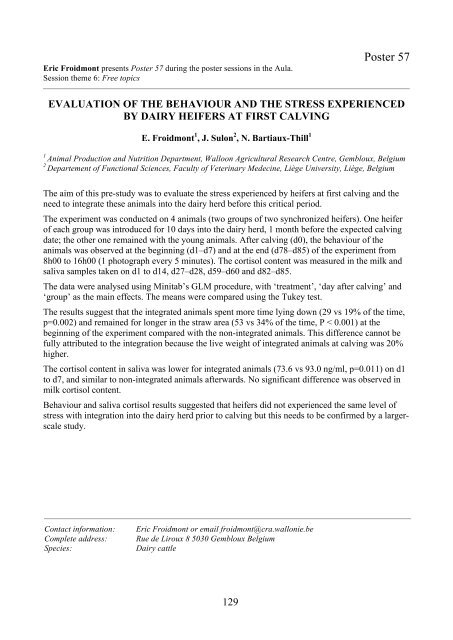Acknowledgements Book of abstracts - Publicaties - Vlaanderen.be
Acknowledgements Book of abstracts - Publicaties - Vlaanderen.be
Acknowledgements Book of abstracts - Publicaties - Vlaanderen.be
Create successful ePaper yourself
Turn your PDF publications into a flip-book with our unique Google optimized e-Paper software.
Eric Froidmont presents Poster 57 during the poster sessions in the Aula.<br />
Session theme 6: Free topics<br />
129<br />
Poster 57<br />
EVALUATION OF THE BEHAVIOUR AND THE STRESS EXPERIENCED<br />
BY DAIRY HEIFERS AT FIRST CALVING<br />
E. Froidmont 1 , J. Sulon 2 , N. Bartiaux-Thill 1<br />
1 Animal Production and Nutrition Department, Walloon Agricultural Research Centre, Gembloux, Belgium<br />
2 Departement <strong>of</strong> Functional Sciences, Faculty <strong>of</strong> Veterinary Medecine, Liège University, Liège, Belgium<br />
The aim <strong>of</strong> this pre-study was to evaluate the stress experienced by heifers at first calving and the<br />
need to integrate these animals into the dairy herd <strong>be</strong>fore this critical period.<br />
The experiment was conducted on 4 animals (two groups <strong>of</strong> two synchronized heifers). One heifer<br />
<strong>of</strong> each group was introduced for 10 days into the dairy herd, 1 month <strong>be</strong>fore the expected calving<br />
date; the other one remained with the young animals. After calving (d0), the <strong>be</strong>haviour <strong>of</strong> the<br />
animals was observed at the <strong>be</strong>ginning (d1–d7) and at the end (d78–d85) <strong>of</strong> the experiment from<br />
8h00 to 16h00 (1 photograph every 5 minutes). The cortisol content was measured in the milk and<br />
saliva samples taken on d1 to d14, d27–d28, d59–d60 and d82–d85.<br />
The data were analysed using Minitab’s GLM procedure, with ‘treatment’, ‘day after calving’ and<br />
‘group’ as the main effects. The means were compared using the Tukey test.<br />
The results suggest that the integrated animals spent more time lying down (29 vs 19% <strong>of</strong> the time,<br />
p=0.002) and remained for longer in the straw area (53 vs 34% <strong>of</strong> the time, P < 0.001) at the<br />
<strong>be</strong>ginning <strong>of</strong> the experiment compared with the non-integrated animals. This difference cannot <strong>be</strong><br />
fully attributed to the integration <strong>be</strong>cause the live weight <strong>of</strong> integrated animals at calving was 20%<br />
higher.<br />
The cortisol content in saliva was lower for integrated animals (73.6 vs 93.0 ng/ml, p=0.011) on d1<br />
to d7, and similar to non-integrated animals afterwards. No significant difference was observed in<br />
milk cortisol content.<br />
Behaviour and saliva cortisol results suggested that heifers did not experienced the same level <strong>of</strong><br />
stress with integration into the dairy herd prior to calving but this needs to <strong>be</strong> confirmed by a largerscale<br />
study.<br />
Contact information: Eric Froidmont or email froidmont@cra.wallonie.<strong>be</strong><br />
Complete address: Rue de Liroux 8 5030 Gembloux Belgium<br />
Species: Dairy cattle
















